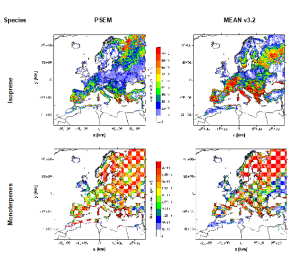- 10/07/2025
- News
Biogenic volatile organic compounds (BVOCs) consist mainly of isoprenoids, such as isoprene, monoterpenes, and sesquiterpenes; alcohols; carbonyls; and acids. These compounds are released into the atmosphere by terrestrial plants. Some isoprenoids react much faster with OH radicals and ozone (O₃) than many anthropogenic VOCs do, so their emission can greatly influence the levels of ozone, photochemical oxidants, and secondary organic aerosols (SOAs) in the troposphere.

However, BVOC emissions are difficult to estimate because plants synthesize different mixtures of compounds that are emitted through various mechanisms. In some species, the flux of photosynthetically active photons (PPFs) reaching the leaf surface, and the leaf temperature trigger the production and short-term emission of BVOCs via the “L+T” mechanism. Conversely, the emission of monoterpenes and sesquiterpenes released by conifers and some fragrant plants follows the “T” emission mechanism, as the release of BVOCs depends solely on temperature. The “L+T” emission mechanism is typical of isoprene-emitting plants but has also been found in some evergreen oaks (Quercus ilex and Quercus suber) that emit monoterpenes, deciduous plants (Fagus sylvatica), and some tropical plants and crops.
The scientific literature has shown that BVOC emissions from Mediterranean vegetation are not accurately estimated by models based on the plant functional types (PFT) approach. Through this approach, plant species are grouped into classes (e.g. broadleaf, needle, shrub, and herbaceous) for which relative emission factors are defined. Within these classes, however, there are species with very different emission characteristics, for example in some oaks the species Quercus ilex does not emit isoprene while the species Quercus pubescens is a high isoprene emitter. To overcome this limitation, we developed a vegetation-specific emission model, so-called PSEM (Plant-Specific Emission Model), which was applied on the Campania region for which a detailed vegetation inventory was constructed. The results obtained through the application of this model were compared with those produced by MEGAN version 2.04, which is a representative example of the PFT approach (see Ciccioli et al., 2023 for a detailed description of the PSEM model and the results obtained). In recent years, Alex Guenther and co-authors have developed a new version of MEGAN (v3.2) that, like PSEM model, allows individual vegetation types (trees, shrubs, grasses, or generic families) to be considered along with their emission factors.
To apply this version of MEGAN, a modeling suite was developed that includes the following modules:
- megan-preprocessor:: This module produces a gridded NetCDF file containing emission potentials, light-dependence factors, and fractional information for six canopy types. This information is derived from the distribution of vegetation types (crops, herbaceous plants, shrubs, and trees) and their emission factors.
- megan: Based on version 3.2 of MEGAN implemented in CMAQ. This module produces a gridded NetCDF file containing hourly BVOC emissions from the file produced by megan-preprocessor, as well as from meteorological hourly fields, soil texture, and leaf area index (LAI) data.
his version of MEGAN was applied to a European domain, and emission estimates from different BVOCs were compared with those produced by PSEM. The following figure shows the average monthly emissions (July 2018) estimated by PSEM and MEGAN v3.2 for isoprene and monoterpenes. Since both models use the same vegetation inventory, the differences between the two models arise from the different emission factors and processes considered by the two models.
Piero Ciccioli, Camillo Silibello, Sandro Finardi, Nicola Pepe, Paolo Ciccioli, Francesca Rapparini, Luisa Neri, Silvano Fares, Federico Brilli, Mihaela Mircea, Enzo Magliulo, Rita Baraldi, The potential impact of biogenic volatile organic compounds (BVOCs) from terrestrial vegetation on a Mediterranean area using two different emission models, Agricultural and Forest Meteorology, Volume 328, 2023, 109255, ISSN 0168-1923, https://doi.org/10.1016/j.agrformet.2022.
Here you can find the presentation showed in “XII Giornata della modellistica in ARIA(NET)”
